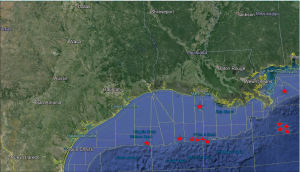For decades we have been trying to develop the desirable imaging and velocity modeling tools for offshore areas with complex geology such as salt geometries. Tomography, Kirchhoff (shallower), Gaussian Beam (deeper), and RTM (deeper) have proven to be some of the most desirable and successful tools in the Gulf of Mexico. Compared to published results, our fault-constrained Tomo with super-dense picking and dip-boosting Beam technologies and Kirchhoff have produced superior images, with quick turn-around that is unmatched in this industry. To tackle imaging of salt structures, we provide unique services such as TOMO/FWI alternating inversion, multi-Z salt modeling, Salt Related Multiple Elimination, and Interactive Imaging (Scenario Testing).
Gulf of Mexico
For the past 20 to 30 years, the seismic industry has been working hard in an attempt to build the ideal tools for Gulf of Mexico imaging. Today, 3D Tomography and Gaussian Beam, Kirchhoff, and RTM have proven to be the most accurate seismic imaging tools available for the Gulf of Mexico. Compared to published results, In-Depth’s Tomo and Beam/Kirchhoff/RTM+ technologies have produced superior images.
In-Depth’s Fault-constrained Tomography with offset/angle gathers takes dense and non-hyperbolic picks and produces high resolution velocity models. Our proprietary K-Semblance produces dip-guided semblance that speeds up the tomographic inversion, while competitors’ vertical semblance-based Tomo will naturally overestimate and fail to produce a desirable resolution with dipping background.
Our speedy Dip Boosting Gaussian Beam is peerless for building salt and fault models. It is unique in the industry, and runs many times faster than Kirchhoff and is excellent in imaging large dips including steep salt flanks. Gaussian Beam naturally handles turning rays and multipathing, for imaging deeper events, large dips, salt flanks, and weak signal areas where Kirchhoff is simply less robust.
For base of salt model building, RTM is needed for its high fidelity of image quality. RTM can also generate angle gathers for subsalt velocity tomographic updating.
For salt model building, our Interactive Imaging provides a very powerful workflow by verifying different salt structures quickly and cost-effectively.
Finally, In-Depth’s tomography, Gaussian Beam, and RTM+ are all capable of dealing with anisotropy. In the Gulf of Mexico, it is crucial to estimate anisotropy in order to tie the wells and flatten the gathers. Anisotropy is also extremely important for a good estimation of volumetrics.
